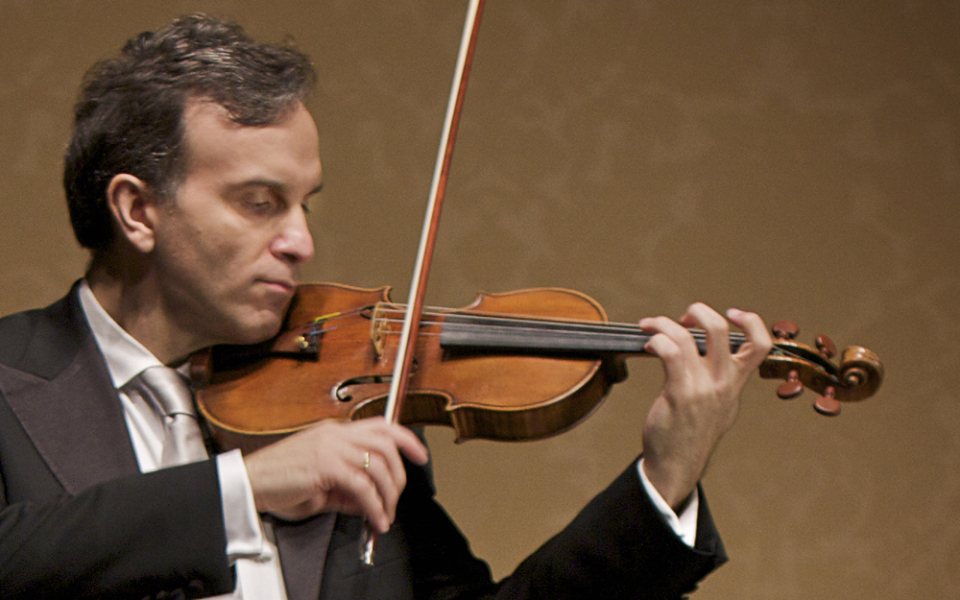
Two great orchestras and soloists shine at Knight Concert Hall

Violinist Gil Shaham, who performed at Knight Concert Hall in Miami on Jan. 9. Photo courtesy of Opus 3.
Separated by mere days, two great orchestras performed at the Adrienne Arsht Center’s Knight Concert Hall in downtown Miami. Attending both concerts was well worth the effort, for valid reasons beyond their artistic merit. For one, the Toronto Symphony Orchestra’s performance on Jan. 7 drove home the need for local audiences to experience ensembles from other cities in order to expand their sound horizons–and also to be able to better measure and evaluate the work of local groups. Therefore, congratulations are due to the Arsht Center’s Classical Series for bringing us this high-quality musical guest, keeping in mind that not long ago many more major orchestras played here than do today. May the large audience the concert drew encourage more visits of this caliber.
Two nights later, patrons were able to enjoy, in the same acoustic environment, the New World Symphony. The adjacent dates unintentionally set up a competition as interesting as it was friendly, and the winner was a doubly enriched audience. On its own, the New World Symphony’s conventional program would have attracted music lovers, but in this case, the star soloist was the big draw, packing the house to an unusual degree.
On Jan. 7, the Canadian orchestra displayed impressive diversity, with an Armenian-Canadian conductor, a Polish-Canadian soloist and a young composer, John Estacio, of Portuguese descent. Estacio’s “Wondrous Light,” describing an aurora borealis, kicked off the program. Brief, powerful and accessible, full of vigorous orchestration and solos, the piece worked perfectly as an introduction to an evening in which the orchestra played the starring role, thanks to conductor Peter Oundjian. Oundjian, well-remembered as the first violin of the Tokyo String Quartet, has been the orchestra’s music director for more than a decade, in addition to fulfilling various international commitments.
In Beethoven’s Piano Concerto No. 4, the performance of 20-year-old Jan Lisiecki, whose career has enjoyed a meteoric rise, was satisfying, though not as dazzling as expected. Lisiecki is well known for his Chopin, Schumann and Mozart, but Beethoven’s Fourth is an Everest for every instrumentalist, no matter how brilliant. Lisiecki delivered a fast-paced performance of undeniable luster, but it was lacking the personal touch that leaves a memorable impression on the listener. More than the required spirituality and power, Lisiecki displayed irreproachable technique and a decidedly classical focus while working with an orchestra that at times provided strong support and at times engulfed him.
Making a well-worn piece like “Scheherezade” sound fresh and interesting is not an easy task, but that is precisely what Oundjian and his orchestra achieved in the second part of that concert. Nikolai Rimsky-Korsakov’s suite became a parade of instrumentalists that displayed all the richness and color of the score. They were led by Jonathan Crow, a first-class first violin capable of eclipsing any soloist. Though “Scheherezade” remains an overused selection, when performed as it was that evening, it is well worth including in a program. In the same Russian vein, the orchestra played as an encore a triumphal Polonaise from “Eugene Onegin” with the same briskness Oundjian lent the entire evening.
The prospect of witnessing the outstanding Gil Shaham play Tchaikovsky’s Violin Concerto in D major guarantees a full house anywhere in the world, even in unpredictable Miami–a city the virtuoso has, fortunately, visited for decades. The house was indeed full on Jan. 9, and Shaham did not disappoint. An illustrious disciple of the legendary Dorothy DeLay (who also taught Itzhak Perlman and Pinchas Zukerman, to name just two), Shaham delivered an immaculate performance marked by the exceptional musicality that has made him a pillar, if not the pillar, of his generation of musicians. Throughout his career, he has always managed to grow or reinvent himself. The smoothness and vigor of his Strad “Comtesse de Polignac” filled the Knight Concert Hall with romantic ardor and exquisite piano sounds that were audible throughout every nook and cranny. This one was indeed a memorable performance. Shaham was attentive and generous to the New World Symphony, which appeared completely comfortable performing with the star soloist. The insistent applause from both audience and orchestra that followed the concerto forced Shaham to return for a sublime encore: the gavotte from Bach’s Violin Partita No. 3. He tackled the piece with a chameleonic change of style, losing nary an iota of personality in the process–a feat reserved for the great.
Cristian Măcelaru, a graduate of the University of Miami’s Frost School of Music and conductor-in-residence of the Philadelphia Orchestra, succeeded in managing the orchestra’s volume and sonority inside a venue that is at times too large for it. But not this time. Măcelaru achieved a large, expansive and consistent sound, perhaps excessively forceful in some cases, but never inappropriate. Beethoven’s “Pastoral Symphony” was cleanly performed, with the required Dionysian touch and a jovial approach that became more dramatic as the piece progressed. There was no dearth of Sturm und Drang, nor of the all-important rustic element. The music flowed and raged like the stream and storm Beethoven depicted. The bassoon, flute and oboe performed excellent turns, as did the strings, whose silkiness lent the final hymn dignified propriety. It was a peaceful and comforting end to two intense evenings of musical enjoyment provided by two orchestras that gave the best of themselves.
Recent Content
-
Artsarticle ·
-
Artsarticle ·
-
Artsarticle ·

